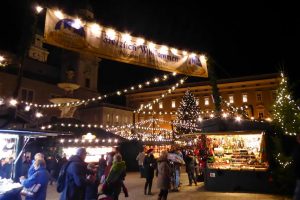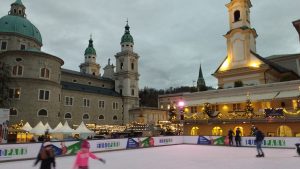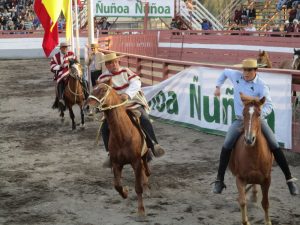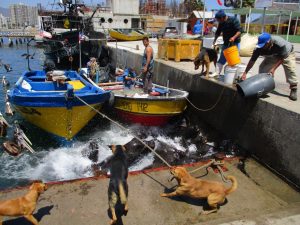This post was written by Martha MacLaren, a fourth-year German and History student at Somerville College.

Walking down Broad Street at the weekend, I was hit by the familiar smell of German sausages and mulled wine, and the hubbub of the Oxford Christmas market brought back memories from my year abroad. In Salzburg, a beautiful cathedral city on the edge of the Alps, I lived right on the central square where the Christkindlmarkt was held every year – that smell wafted through my window whenever I dared to open it to the below-freezing temperatures in frosty December!
Christkindlmarkt is the Austrian equivalent of the German Weihnachtsmarkt. The latter translates as Christmas market, but the Austrian reflects the tradition of the Christ Child who visits children with presents on 6th December. Christ means Christ, and Kindl is the diminutive of Kind (child) – so ‘little-Christ-child market’. In Austria, an “l” is often used instead of a German “chen” – “Mädel” instead of “Mädchen”, for example. You can see why it’s easier to yodel in Austrian German!

Sausages such as Bratwurst and Käsewurst (sausage with cheese inside – delicious) were sold for about half of the £6 you’d pay for them here – and not in a hot dog bun, but with a Semmel, a bread roll. They’d probably be served with Sauerkraut und Senf (pickled cabbage and mustard), which is as disgusting as it sounds! Glühwein (mulled wine) was a favourite, and you needed it to warm your hands, especially after ice skating on the outdoor rink on Mozartplatz. Kaiserschmarrn, thick and fluffy torn up pancakes, were cooked on a griddle and served with Apfelmus (apple sauce) or Zwetschkenröster (stewed plums). There’s another word – Zwetschke – that’s different from the German (Pflaume).
Beautiful decorations, organic chocolate and fancy soaps abounded, alongside the classic Mozart-themed touristy gifts. Salzburg is very proud of its most famous cultural export! The tasteful lights and Christmas tree topped off the scene, with the cathedral and fortress forming the backdrop. I can’t wait to go back, but this year I’ll content myself with Oxford’s buzzing market as term comes to an end.




